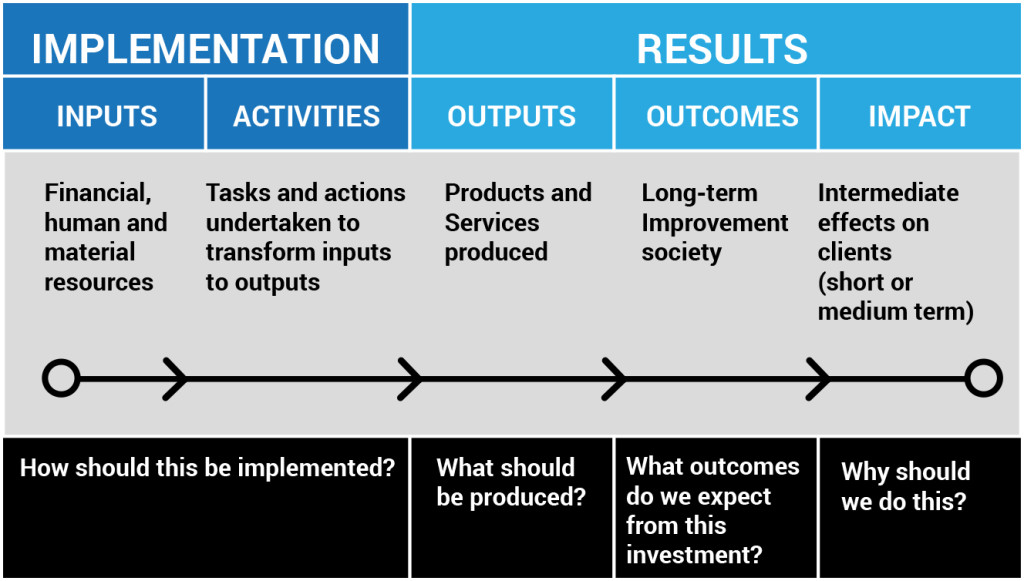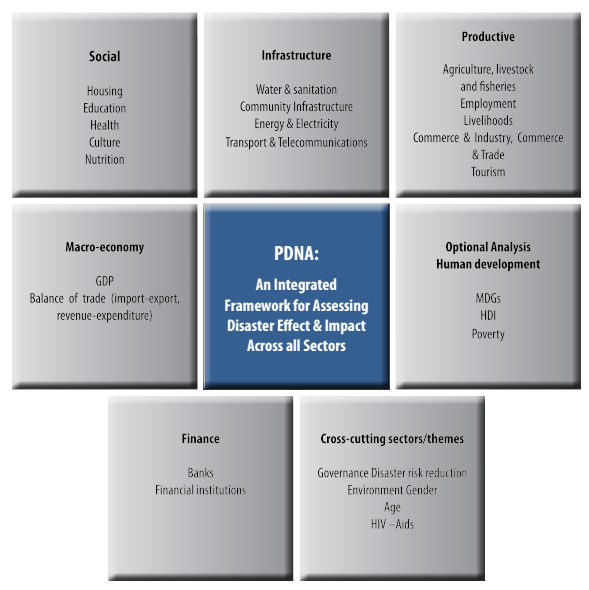INTRODUCTION
Immediately after a local area or country has been affected by a major disaster event, humanitarian needs will normally be the primary focus. The first priority is to save lives, treat the injured, provide access to basic services, and conduct urgent short-term repairs. Early recovery – a multidimensional process of recovery that begins in a humanitarian setting according to the UNDP “Guidance Note on Early Recovery” (2008) – follows once the situation is stabilized and gradually shifts towards meeting the medium to long-term needs for recovery and reconstruction.
Post-disaster recovery is about re-establishing basic services and livelihoods that will normalize the socio-economic conditions and human recovery needs in the affected areas. With an appropriate recovery process, governments are enabled to prepare a recovery and reconstruction plan that is responsive to the identified needs and priorities. A credible and comprehensive plan will hasten the transition from disaster response to recovery. A good recovery plan will also identify long-term reconstruction needs and the potential source of national and international funds to address the needs. The planning process must be achieved expeditiously, yet with enough transparency and accountability of all the stakeholders, in order to start the implementation of urgent projects.
PURPOSE OF A POST-DISASTER RECOVERY AND RECONSTRUCTION PLAN
The purpose of developing a post-disaster recovery and reconstruction plan is as follows:
- To provide a framework for the smooth transition from disaster response towards early recovery to medium and longer-term reconstruction that will establish priorities, programming interventions, allocation of resources, and an effective monitoring and evaluation component.
- To propose recovery and reconstruction strategies to achieve the desired outcomes and activities required for each of the key affected sectors, in consideration of the stakeholders’ view.
- To propose the implementation modality for coordinating, communicating, monitoring and evaluation of the recovery and reconstruction efforts.
- To engage development partners to support the recovery and reconstruction needs of the affected area/s.
UNDERSTANDING THE PLANNING PROCESS
The diagram below defines and shows the relationships among the recovery planning parameters
 Source: adapted from “An Introduction to Results Management Principles, Implications and Applications”, Asian Development Bank (2006).
Source: adapted from “An Introduction to Results Management Principles, Implications and Applications”, Asian Development Bank (2006).
A full post-disaster recovery plan must have a complete set of goal or vision, objectives, outcomes, outputs, activities, inputs and the implementation arrangements which include the monitoring and evaluation aspects as well as feedback mechanisms. For the purpose of this guide, the following definitions are adapted from GFDRR et al (2014) “Guide to Developing Disaster Recovery Frameworks” and UNDP (2009) “Handbook on Planning, Monitoring and Evaluation for Development Results”.
- VISION is how things will have positively changed in a period of time (normally 5 to 10 years after a disaster). It is in terms of how the region, society, community or affected people’s lives will have recovered and improved within the time period. The vision enables the government to articulate and communicate its reconstruction priorities, and is more effective if defined for a broad consensus among recovery stakeholders. Good questions to ask are: “If we were successful in dealing with this problem, what would this area or community be like in five years?” “What would a resilient or ‘built-back-better’ community look like?”
- IMPACTS are actual or intended changes in human development, measured by people’s well-being after disasters. This could be society-wide, or at sector-wide and geographic/area levels, relating to health, welfare, livelihoods, etc. However, in most cases, impacts cannot be fully and directly attributed to specific interventions because of the complexity of influencing factors. An impact statement explains why the recovery work is important and can inspire people to work toward a future to which their activities contribute.
- OUTCOMES are actual or intended changes in post-disaster conditions that recovery interventions are seeking to support. The outcomes are direct benefits for target groups or beneficiaries of the outputs or deliverables of a recovery intervention at plan, policy, program or project levels. Outcomes provide a clear statement of what has changed or will change in a particular region or community within a period of time, normally in the medium term or at the completion of the intervention. Outcomes cannot normally be achieved by only one department or stakeholder and are not under the direct control of a project manager. An outcome should be measurable using indicators. It is important that the formulation of the outcome statement takes into account the need to measure progress in relation to the outcome and to verify when it has been achieved. The outcome should therefore be specific, measurable, achievable, relevant and time-bound (SMART).
- OUTPUTS are short-term results produced by recovery activities (generally projects and non-project activities). The outputs must be achieved with the resources provided and within the time-frame specified (usually less than five years). Since outputs are the most immediate results of program or project activities, they are usually within the greatest control of the government or the project manager.
It is important to define outputs that are likely to make a significant contribution to achievement of the outcomes. In formulating outputs, the following questions should be addressed:
What kind of policies, guidelines, agreements, products and services do we need in order to achieve a given outcome?
Are they attainable and within our direct control?
Do these outputs reflect an appropriate strategy for attaining the outcome?
Is there a proper cause and effect relationship?
Do we need any additional outputs to mitigate potential risks that may prevent us from reaching the outcome?
Is the output SMART—specific, measurable, achievable, relevant and time-bound?
It is important to bear in mind that outputs must be deliverable within the respective programming cycle.
Typically, more than one output is needed to obtain an outcome.
- ACTIVITIES describe the actions that are needed to obtain the stated outputs. Activities relate to the processes involved in generating tangible goods and services or outputs, which in turn contribute to outcomes and impacts. Activities are generally at the level of programs, activities and projects.
In formulating activities the following questions should be addressed:
What actions are needed in order to obtain the output?
Will the combined number of actions ensure that the output is produced?
What resources (inputs) are necessary to undertake these activities?
- INPUTS are essentially the things that must be put in or invested in order for activities to take place. Inputs include money; personnel; equipment; technology; and materials. The general tendency is to use money as the main input, as it covers the cost of consultants, staff, materials, and so forth. However, in the early stages of planning, effort should be spent on identifying the various resources needed before converting them into monetary terms.
- INDICATORS are signposts of change along the path to development. They describe the way to track intended results and are critical for monitoring and evaluation. Good performance indicators are a critical part of the results framework.
STRATEGIC RECOVERY FRAMEWORK
The achievement of the desired outcomes and impacts will require a strategic framework that will define the best options to choose – from the procurement of inputs and the implementation of activities – to deliver the intended outputs.
Strategies should be the most effective and efficient ways to achieve the outcomes and outputs which could be imbedded in, among others:
- The implementation part (creation of special agencies; timing; coordination and collaboration arrangements; monitoring and evaluation; etc.)
- Application of modern technology in construction (methods/design, materials, etc.);
- Financing of programs and projects (loans; grants; public-private partnership; taxation; etc.)
- Skills and human capacity development; and
- Sustainability
POST-DISASTER NEEDS AND PRIORITIES FOR RECOVERY PLANNING
Post-disaster assessment involves the timely and accurate estimation of damages, losses, impacts, and needs across different sectors such as transportation, health, and agriculture. The assessment helps identify the areas with the greatest need, assists prioritization of recovery tasks, and supports the mobilization of resources from the government and development partners. Therefore, the assessment feeds directly into recovery planning.
In the same way that a risk assessment is necessary to identify pre-disaster risk reduction measures, post-disaster assessment is essential to identify recovery and reconstruction activities. The assessment report therefore is a key decision-making tool for recovery planning.
The preparation of the recovery plan must commence after the completion of a post-disaster assessment. Depending on the scale of the disaster and the needs, the timeframe of the recovery plan can range from 3 to 5 years or more. The assessment report should guide the timeframe of the recovery plan.
| AN INTERNATIONAL METHODOLOGY FOR POST-DISASTER NEEDS ASSESSMENT |
| Originally developed by the United Nations Economic Commission for Latin America and the Caribbean (UN-ECLAC) in 1972, the post-disaster needs assessment methodology has been used after large disasters across the globe. The methodology offers a Government-led systematic process to quantitatively assess the damage, loss, and needs across all development sectors in a country after a disaster. In 2014, the World Bank, United Nations, and European Commission agreed to standardize the methodology so as to offer more effective support to countries. |
| The following general steps are typically conducted in a post-disaster needs assessment: 1. Collect baseline information for all sectors 2. Assess damages and losses for all sectors (effects) 3. Assess disaster impacts (social, macro-economic, cross-cutting issues) 4. Define recovery strategy (prioritized needs, programs, and projects) |
| DEVELOPMENT SECTORS FOR ASSESSMENT |
| In the international methodology, the following sectors may be assessed as part of the post-disaster needs assessment:
Source: adapted from the “Post-Disaster Needs Assessments Volume A: Guidelines” by the Global Facility for Disaster Reduction and Recovery (GFDRR) of the World Bank, the European Union, and United Nations Development Programme (UNDP), 2014. |
The results of the assessment provide helpful information to understand needs and priorities for recovery, including:
|
| INTERNATIONAL METHODOLOGY ADAPTED TO COUNTRY REQUIREMENTS |
In order for countries to strengthen systems for post-disaster assessment and recovery planning, several national Governments in Southeast Asia have adapted the international PDNA methodology to specific country context and needs. The adaptation process is normally necessary for the following reasons:
|
| Examples of country-specific post-disaster needs assessment guidelines are available for download in this website. The requirement to adapt the international methodology for country requirements is explained in the “Post-Disaster Needs Assessments Volume A: Guidelines”. |
